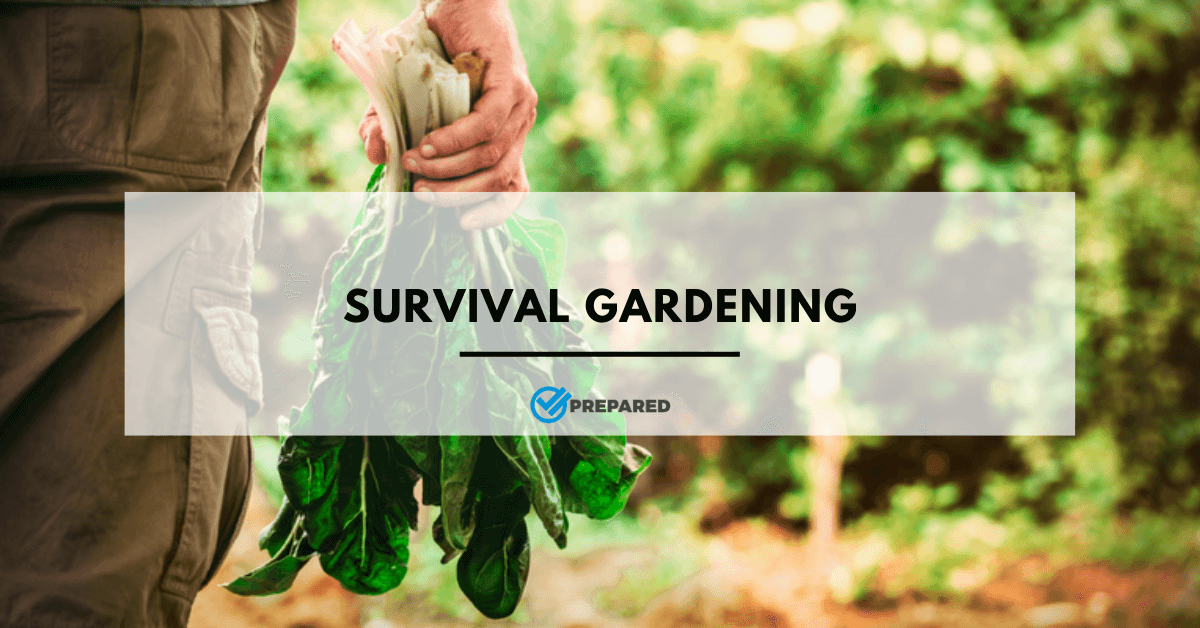When you think about surviving after a major disaster or some other event that disrupts the food supply chain, you realize you need to grow your own food. This is the aim of survival gardening. Many of us, already have gardens that we like to grow in the summer. The garden is more of a hobby and a source of joy rather than a necessity. If your tomatoes do not ripen or grasshoppers destroy your leaf crops, it is not that big of a deal. You will just run to the market and grab what you need.
However, when your garden is your primary food source, you need to get serious about growing food. A hobby garden is a luxury. A sustainable garden is a necessity. Let’s get into some of the questions you may have about survival gardening.
Can a Garden Provide Enough Food?
This is a tricky question, and the answer is not a simple yes or no. Yes, your garden can provide enough nutrition to keep your body healthy. Will you feel full? Probably not. Will vegetables and fruits in your garden provide all the calories you need? Probably not. With that said, a garden provides you with a source of raw fruits and vegetables which your body needs. Depending on the size of your garden, you will be able to preserve the excess to carry you through times when the garden is not in full swing. Your survival garden needs to be productive enough to keep your family fed. You will need to supplement what you get from your garden with meat you harvest from the wild or bread you bake.
Choosing Vegetables, Fruits, and Herbs
Garden space is going to be at a premium. You have to spend some time planning. Every inch of space in the garden could mean the difference between eating and starving. Here is where quality counts. You need the veggies and fruits that are going to give you the most nutritional value, as well as big producers with little space. Strawberries are an excellent fruit choice. They can be placed in containers and will still be prolific.
Vegetables like kale, carrots, spinach, tomatoes, and broccoli pack a big load of vitamins and minerals that your body will need. Herbs are very prolific. You only need a single plant to get what you need. Herbs can be grown in containers right in your window sill. You need to pick plants that are nutritious and don’t take up much space. Things like corn, squash, and zucchini take up much space and do not provide a lot of nutritional value.
Survival Gardening in a Cold Climate?
You can still find a way to grow food, even if you live in a cold climate. You may not be able to grow peppers, tomatoes and other plants that need a long growing cycle, but there are plenty of other options. Choose plants that will thrive in cold conditions. Peas, lettuce varieties, cabbages, spinach and most root crops will do okay in cool climates.
You might consider putting together a cold frame. Cold frames are small greenhouses that keep plants warm and allow them to thrive, even when there is snow on the ground. A greenhouse is also an option. You can build a greenhouse for under a couple of hundred dollars using fence panels and thick plastic. Your primary goal is to extend the growing season. You need to grow food all year round, which is possible with a greenhouse that is set up in an area that gets full sun.
Growing food indoors in a bright window is an option, but filtered sunlight is not quite the same as direct sunlight. You may need to have a couple of grow lights to help the plants thrive.
When Will You Get to Harvest?
All plants will have different growth needs. Ideally, you will want to use heirloom seeds and stay away from the hybrids that have been developed to have shorter growing cycles. Leafy plants typically mature the fastest and will be ready in as little as two months. Things like spinach and broccoli can be harvested over a period of time. You leave the plant in the ground and collect a little every few days. Vegetables like tomatoes, peppers, and potatoes will need 60 to 90 days before they are ready to harvest.
Research succession planting to learn more about ensuring how to always have fresh food ready to harvest. With succession planting, you plant seeds every week. This way, your garden does not all mature and need to be harvested at the same time.
How Much Land Do You Need?
While it would be great to have an entire acre dedicated to your survival garden, you can do with far less. It is all about using companion planting and putting plants together that can thrive without pushing each other out. Something that is commonly used in small spaces is called the ‘3 sisters’. Corn, squash, and peas are all planted in the same area. The squash covers the ground, the peas climb the stalks, and the corn provides the shade for the peas. Companion planting is very useful. Always remember you can also use container gardening and vertical gardening, which means you use containers that are fastened to a wall or fence.
Is Crop Rotation Necessary?
Crop rotation is critical when you are planting directly in the soil. It is done for a couple of different reasons. Firstly, you do not want to deplete the soil of nutrients. Plants like peas, for example, put nitrogen into the ground, while tomatoes and corn draw it out. Even with good crop rotation, you will want to add compost to help feed the soil.
Another reason why crop rotation is necessary is to reduce the risk of disease and bugs that will destroy your crops. Potatoes should be planted in a different spot each year to avoid getting potato bugs that will decimate your crop. You will not want to put anything from the same family into the area, like tomatoes. Crop rotation is necessary, and you will need to spend some time researching it. Make sure you keep good notes about what was planted where so that you can plan accordingly during the following growing season.
Next Steps for Your Survival Garden
This article provided a few suggestions on how to start a survival garden. The important aspect is to do research to determine which approach will meet your unique requirements. You can also start small and test different approaches. Over time you can then gradually work towards a fully-fledged sustainable survival garden.
Survival gardening for beginners. Do you want to start your own survival garden, but don’t know where to start? Start by learning about companion planting and do it right from the start. Or build a small greenhouse to get started.

Chris was born and raised in South Africa and has worked in the field of risk management, organisational resilience, and business continuity for more than a decade. During his career he has seen how private and public sector organisations benefit from effective risk management and business continuity planning. Realising that families and communities can also benefit from the same tools, methodologies, and principles, he started Prepare with Foresight.
Prepare with Foresight was launched to assist individuals and families to have the peace of mind that they will be able to recover from and successfully adapt to the consequences of adverse events.

